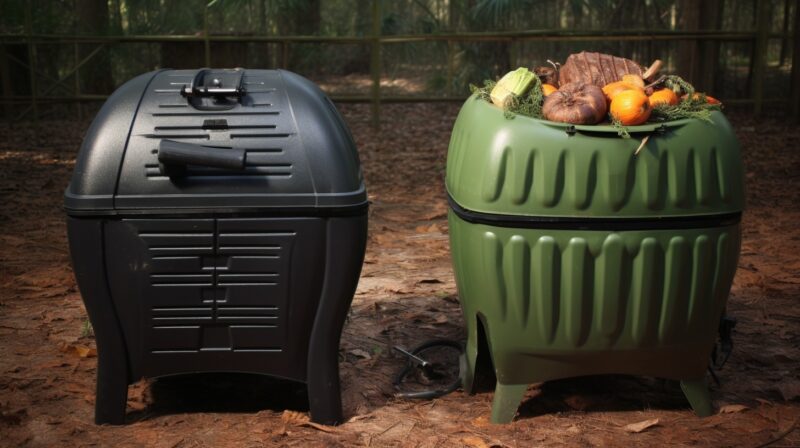Composting is not just an environmentally friendly practice; it’s a commitment to nurturing our gardens and reducing waste.
My experience with various composting methods has taught me that the key to successful composting lies in understanding the different systems available.
That is why I’m excited to share insights on the choice between compost tumblers and bins, a decision that many eco-conscious gardeners face.
How Compost Tumblers Work
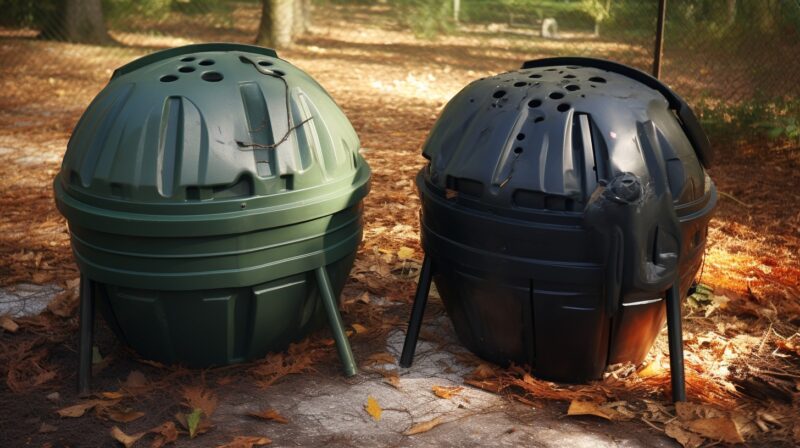
Tumblers are a modern and efficient approach to composting, particularly suited for gardeners who value ease and speed in their composting processes. These innovative devices are typically constructed from robust materials like plastic or metal and are uniquely designed to rotate on an axis.
This pivotal feature of tumbling is instrumental in aerating the composting materials, thereby significantly accelerating the decomposition process, much like the principles applied in compost toilets. The mechanism of a tumbler is akin to that of a toilet, where aeration is key to breaking down organic matter.
In a tumbler, this is achieved through its rotational movement. Most models are equipped with a convenient door, allowing for the easy addition of new materials, such as kitchen scraps or garden waste, and the removal of finished compost.
This feature is particularly useful in managing compost in a more controlled and hygienic manner, a benefit also observed in compost toilets, where waste is decomposed in a contained environment. Despite their compact size, typically holding about 1-2 cubic feet of waste, tumblers are quite effective.
This size makes them an ideal choice for smaller gardens or urban spaces where a larger bin might not be feasible. It’s worth noting that their innovative design and convenience come with a higher cost, with prices ranging from $80 to over $400.
Benefits of Using a Compost Tumbler
I’ve found compost tumblers to offer several significant advantages that can enhance the experience:
- Faster Composting Time: The most notable advantage of compost tumblers is their ability to speed up the composting process. While traditional bins can take several months to produce usable compost, tumblers can dramatically reduce this time to as little as 4-6 weeks. This is particularly beneficial for gardeners who need compost more frequently or have limited space for multiple compost heaps.
- Ease of Use: One of the reasons I often recommend tumblers to beginners is their ease of use. Unlike compost bins that require manual turning with a fork or shovel, tumblers simplify this process with an easy-to-rotate drum. This feature not only saves time but also reduces the physical effort required, making it an excellent option for individuals who may find manual turning challenging.
- Pest Control and Odor Management: In urban environments or areas with wildlife, pest control is a significant concern in composting. Tumblers, with their enclosed design, effectively keep critters out and help contain odors, which can be a problem with open composting systems. This containment makes tumblers a more neighbor-friendly option, especially in densely populated areas.
- Ideal for Small Spaces: Tumblers are generally more compact compared to traditional bins, making them an ideal choice for small yards, patios, or urban gardens where space is at a premium. Their neat, contained design fits well in smaller areas without sacrificing functionality.
- Easy Aeration and Mixing: Proper aeration is key to successful composting. Tumblers are designed to make aeration and mixing of compost materials effortless. With each rotation, the contents are mixed and aerated, which is essential for breaking down organic matter efficiently and producing high-quality compost.
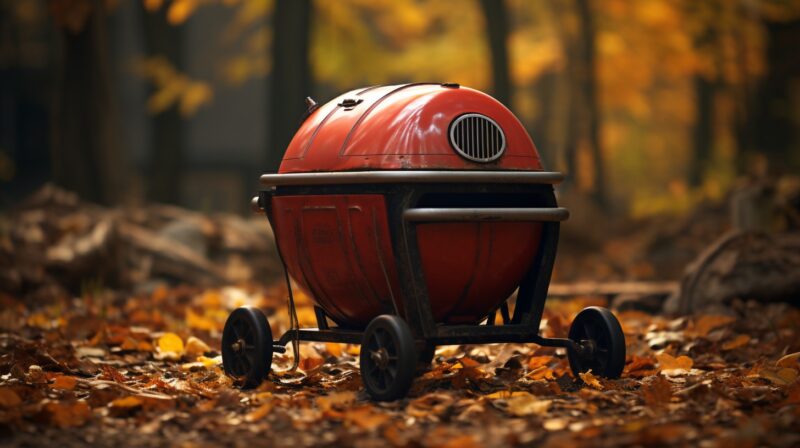
Drawbacks of Compost Tumblers
Despite their benefits, compost tumblers have limitations:
- Limited Capacity: Tumblers typically have a smaller capacity compared to compost bins. For households or gardens that produce a significant amount of organic waste, a tumbler might not be sufficient. This limitation can be a concern for avid gardeners or those looking to compost most of their yard and kitchen waste.
- Risk of Drying Out: The enclosed, often sun-exposed design of tumblers can lead to faster drying out of compost material. Maintaining the right moisture level is crucial for composting, and tumblers may require more frequent monitoring and water addition to keep the compost process active.
- Material Jamming: The design of tumblers can sometimes lead to materials clumping and jamming, particularly if not loaded correctly or if the balance of green and brown materials is off. This issue can hinder the composting process and may require additional effort to correct.
- Durability Issues: Depending on the material, some tumblers may crack or degrade over time, particularly under harsh weather conditions. Durability is an important consideration, especially for gardeners in areas with extreme climates.
- Difficulty with Bulky Materials: Adding large or bulky materials like branches or thick stems can be challenging with tumblers. The limited opening and space inside the drum make it hard to compost larger pieces, which are often easier to manage in open bins.
How Compost Bins Work
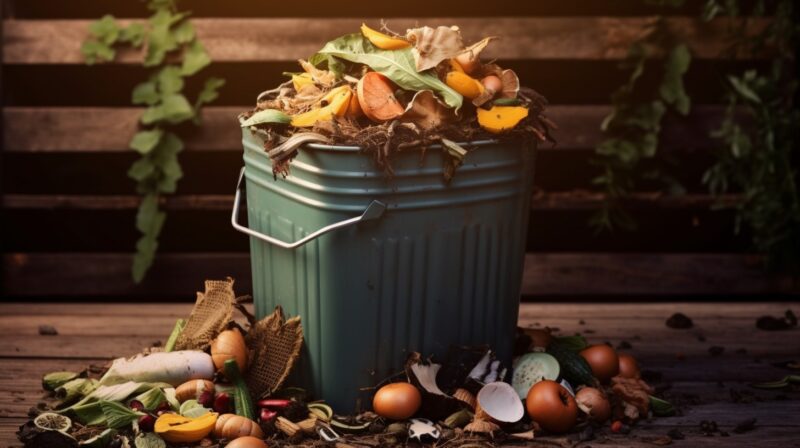
Compost bins represent the quintessential method in the realm of composting, embodying a blend of simplicity and natural processes. Rooted in traditional practices, these bins can range from basic piles in a backyard to more elaborate structures crafted from wood, plastic, or wire mesh.
Their design and operation hinge on the principle of natural decomposition, where organic matter breaks down over time through the activity of microorganisms. The operation of a compost bin is inherently more passive compared to the dynamic nature of tumblers.
Organic materials such as kitchen scraps, yard waste, and garden trimmings are collected and left to decompose naturally. This decomposition is a slow and steady process, facilitated by the diverse microbial life that thrives in the compost environment.
The role of these microorganisms is crucial – they break down the organic matter, transforming it into rich, nutrient-dense compost over time. This process isn’t entirely hands-off. To ensure effective composting, the contents of the bin require periodic turning.
This turning is not just a physical mixing of materials but a vital step in introducing air into the compost. Aeration is key to keeping the composting process aerobic, which not only speeds up decomposition but also helps in controlling odors and deterring pests.
Benefits of Compost Bins
I have observed numerous advantages of using bins, making them a popular choice among garden enthusiasts:
- Affordability: One of the most appealing aspects of bins is their cost-effectiveness. Many models and DIY options are available at a price point under $50, making them accessible to a wide range of gardeners. This affordability is especially advantageous for those new to composting or operating on a tight budget.
- Larger Capacity: Bins typically offer a larger capacity than tumblers. They can handle significant volumes of organic waste, making them ideal for avid gardeners, large families, or those with spacious yards. This capacity is beneficial for managing the continuous influx of kitchen scraps, lawn clippings, and leaves, especially during peak gardening seasons.
- Flexibility with Materials: Bins provide the flexibility to add a variety of materials, including bulky yard debris like branches and twigs, which can be challenging to accommodate in tumblers. This flexibility is crucial for efficient waste management and creating a balanced compost mix.
- Customizability: Another significant advantage is the ability to customize bins. You can easily construct a bin to fit specific dimensions of your space, whether it’s a small corner of a city yard or a larger area in a rural garden. This customizability allows for a more personalized and space-efficient composting solution.
- Reduced Drying Out: Due to their design and larger volume, bins tend to retain moisture better than tumblers. Adequate moisture is essential for the composting process, aiding in the breakdown of organic matter and fostering the right environment for microbial activity.
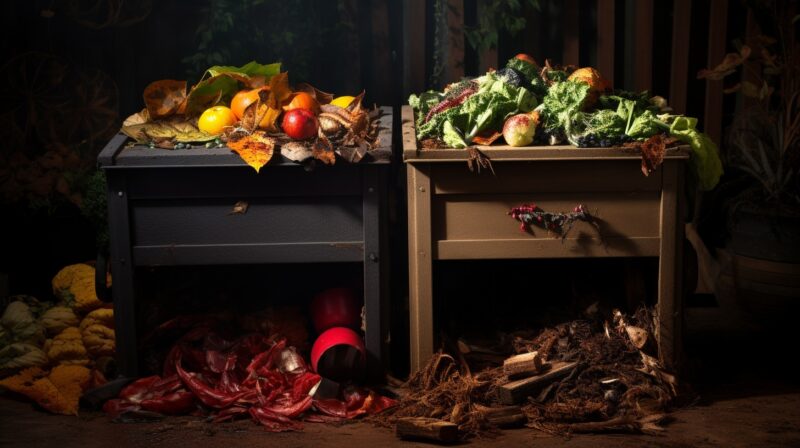
Drawbacks of Compost Bins
Despite these benefits, compost bins also present some challenges:
- Slower Composting Process: Unlike tumblers, which can expedite the composting process, bins generally take longer – from several months up to two years – to produce finished compost. This slower process requires patience and may not be suitable for those who need compost more rapidly.
- More Physical Effort: Compost bins demand more physical labor, particularly when it comes to turning and mixing the materials to ensure proper aeration. This effort can be a significant consideration for those who may find such physical tasks challenging.
- Potential for Pests: If not properly maintained, bins can attract pests like rodents and insects. This issue is especially pertinent in open-bin designs where organic material is more accessible to animals.
- Odor Issues: The open nature of many bins can lead to more pronounced odors, a factor that may be of concern in urban or suburban settings where neighbors are in close proximity.
- Compaction and Aeration Issues: Over time, materials in bins can become compacted, especially at the bottom, reducing aeration and potentially slowing down the composting process. This compaction requires regular monitoring and turning to maintain effective composting conditions.
FAQs
What type of container is best for compost?
The best type of container for compost depends on your needs. A closed container like a tumbler is ideal for quick composting and pest control, especially in small spaces. Open bins or piles are better for larger volumes and are more cost-effective. Choose based on your space, the amount of waste, and your composting goals.
Do tumbler composters leak?
Generally, tumbler composters are designed to be leak-proof and contain moisture and compost material effectively. However, some models might experience condensation or slight leakage, especially if overfilled or not balanced properly.
Does a compost bin need air holes?
Yes, a compost bin needs air holes for aeration, which is crucial for the composting process. Proper aeration helps in maintaining the right balance of moisture and temperature, and it aids in the breakdown of organic matter by aerobic bacteria.
Is wood or plastic composter better?
Both wood and plastic composters have their advantages. Wood composters are breathable, blend naturally into garden settings, and can be more durable. Plastic composters are lightweight, often cheaper, and can retain moisture and heat more effectively. Your choice should depend on your climate, aesthetic preference, and budget.
Epilogue
Compost tumblers offer quick and easy composting with some limitations in size and cost, while bins provide larger capacity at lower prices but require more effort and maintenance.
When choosing the right system, consider factors like your budget, the volume of yard waste you generate, and space constraints.
Ultimately, both systems can produce high-quality compost; the choice depends on what best suits your gardening style and needs.
Related Posts:
- How to Layer a Compost Bin: Transform Your Waste into Gold
- How to Use a Tumbling Composter: How to Use it Like a Pro
- Cane Corso vs Rottweiler: Which Guard Dog is Right for You?
- Which Mammals Can Fly? - The Only True Flyers and…
- Compost 101: A Beginner's Guide to Organic Composting
- How to Make a Compost Heap: 10 Top Tips - Waste Not,…


